#appalachian violet
Text

Viola appalachiensis / Appalachian Violet at the Sarah P. Duke Gardens at Duke University in Durham, NC
#Viola appalachiensis#Viola#Appalachian Violet#Appalachian#appalachia#Native plants#Native flowers#Nature photography#photographers on tumblr#Sarah P. Duke Gardens#Duke Gardens#Duke University#Durham#Durham NC#North Carolina#Violet
0 notes
Text
Donations for Appalachian/Southeast USA Queer Organizations
Here lies the sister post to my resource list.
Under the cut, you'll find a list of regional, primarily queer-focused groups to donate to, if you have the means.
If you've ever accused us of being beyond help, or have ever said we should be sawed off into the ocean, here's your chance to help the many helpers trying to make the southeast a better place--those that always go conveniently ignored in such conversations.
General Regional Links
Appalachian Outreach
STAY (Central Appalachia)
Help suspected transgender John and Jane Does regain their identities
Southern Trans Youth Emergency Project (STYEP)
Southerners on New Ground (SONG)
Campaign for Southern Equality
Trans Health Project
Alabama
AIDS Alabama
The Knights & Orchids Society
Magic City Acceptance Center
Medical Advocacy and Outreach
Prism United
Shoals Diversity Center
T.A.K.E.
Thrive Alabama
Georgia
Carrollton Rainbow Inc.
Emmaus House
Feminist Women’s Health Center
First City Network
Georgia Equality
Kentucky
AIDS Volunteers of Lexington
Arbor Youth Services
Lexington Pride Center
Louisville Queer Youth
Louisville Youth Group
Kentucky Fairness
Kentucky Health Justice Network
Kentucky Youth Law Project
Sweet Evening Breeze
Louisiana
AcadianaCares
Louisiana Trans Advocates
OUTnorthla
PACE Louisiana
Shrevepride
Mississippi
Capital City Pride
Gulf Coast Equality
LGBTQ Fund of Mississippi
The Spectrum Center in Hattiesburg
Violet Valley Bookstore
North Carolina
Charlotte Transgender Healthcare Group (CTHCG)
Down Home NC
Guilford Green Foundation & LGBTQ Center
Pitt County Aids Service Organization
Tranzmission
Triad Health Project
Triangle Empowerment Center
South Carolina
Alliance for Full Acceptance
Charleston Black Pride
Harriet Hancock Center
Palmetto Community Care
T-Time
Uplift Outreach
We are Family
We are Family Trans Love Fund
Tennessee
CHOICES
Launch Pad
Metamorphosis
Mountain Access Brigade
My Sistah’s House
Pride Community of the Tri-Cities
Trans Empowerment Project
Youth Villages
Virginia
Justice 4 All
Nationz
Side by Side VA
Virginia Home for Boys and Girls
West Virginia
Harmony House West Virginia
Fairness West Virginia
Holler Health Justice
WVFREE
#appalachia#appalachian#southeast usa#queer#anti-fascist south#donations#donate#queer resources#alabama#georgia#kentucky#louisiana#mississippi#north carolina#south carolina#tennessee#virginia#west virginia
165 notes
·
View notes
Photo
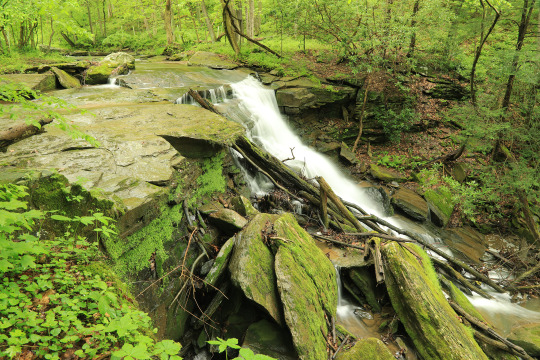

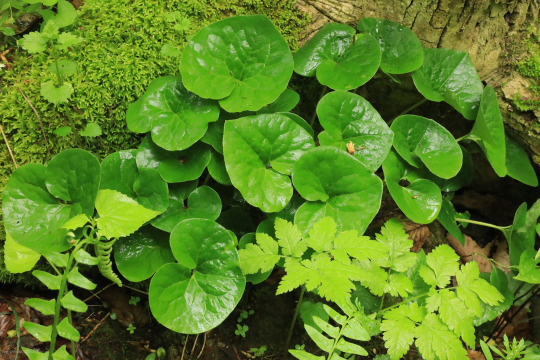


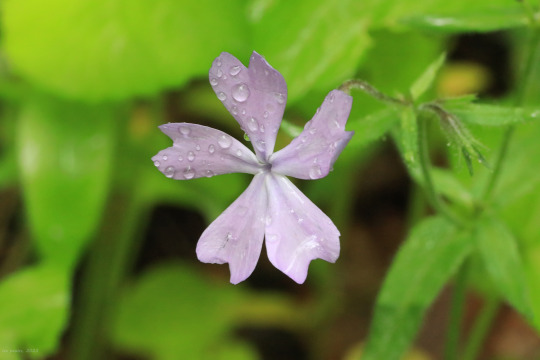
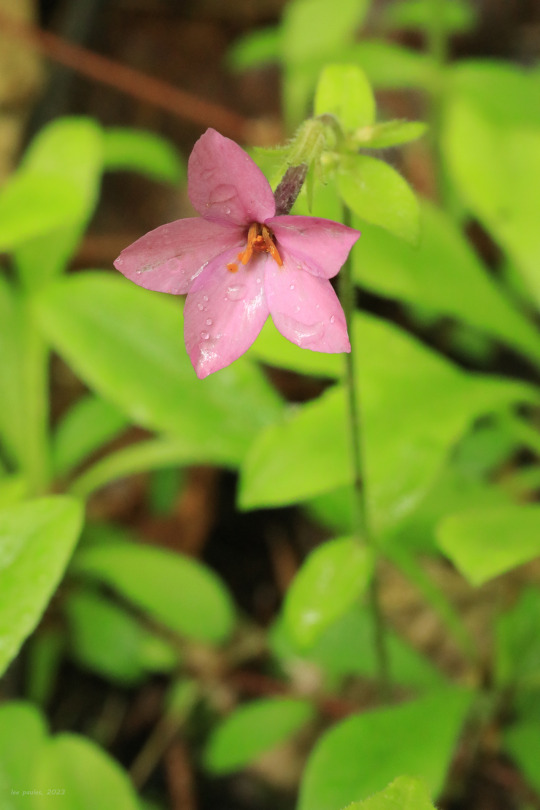
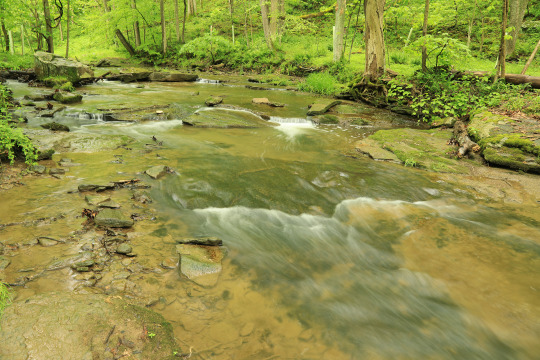
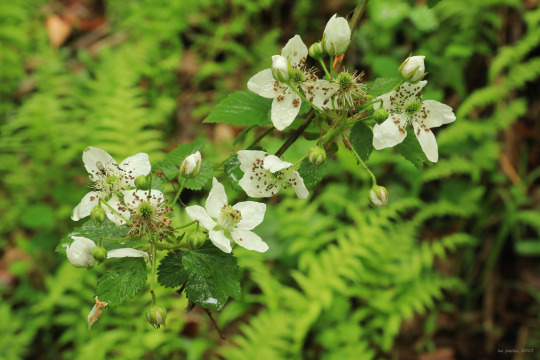
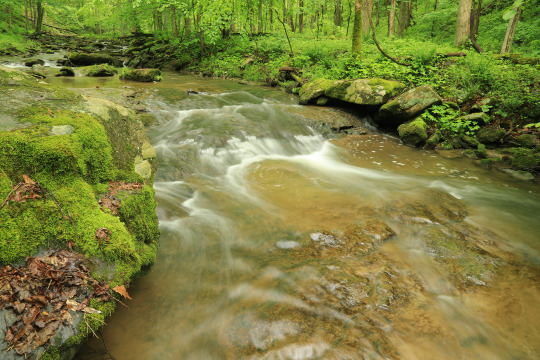
Part 2: After the Rain - Life in an Appalachian Temperate Forest.
From top: Wild ginger (Asarum canadense), also known as Canadian snakeroot; Philadelphia fleabane (Erigeron philadelphicus), a lovely spring aster deserving of a more dignified name; white wood violet (Viola sororia albiflora), a white variation of the common blue violet; woodland phlox (Phlox divaricata), also called wild blue phlox; creeping phlox (Phlox stolonifera), a mountain native and the most delicate and beautiful of Appalachia’s many wonderful phlox species; and Allegheny blackberry (Rubus allegheniensis).
#appalachia#vandalia#west virginia#toms run preserve#west virginia land trust#temperate forest#rain#intense green#flora#wildflowers#may#wild ginger#canadian snakeroot#phildaelphia fleabane#white wood violet#woodland phlox#wild blue phlox#creeping phlox#allegheny blackberry#common blackberry
458 notes
·
View notes
Text
Every Current Formula 1 Driver But I Decided They Were All Bugs
No Thoughts, Head Empty, Only Insects I Enjoyed From My Single Entomology Class Several Years Ago. Sorry to folks from outside the states. Most of these are like. my local critters.
Max Verstappen - Appalachian Jewelwing, Calopteryx angustipennis I have no reasoning behind this one. He just gives me the vibes of a damselfly kinda man.
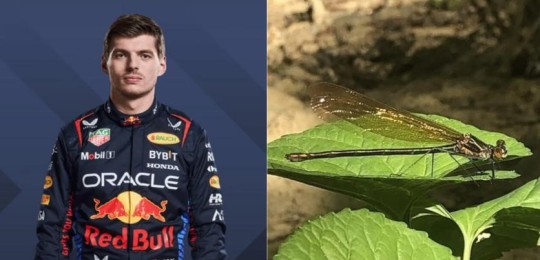
Sergio Pérez - Synoeca Cyanea, a species of warrior wasp, or just the Synoeca genus again, literally no justification besides he's on the dark blue team and I just really like these wasps. Please read the Synoeca wikipedia page. they are SO cool.

Lewis Hamilton - Violet Carpenter Bee, Xylocopa violacea fashionable! cool lookin bee!
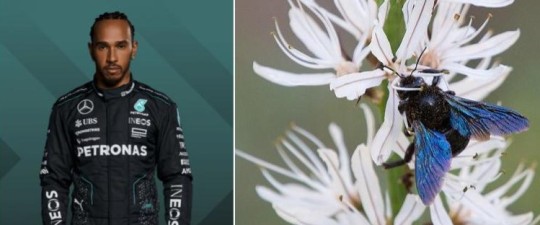
George Russell - Blue Hawker, Aeshna cyanea

Charles Leclerc - Cattle Killer/Cow Killer, Dasymutilla occidentalis (letting my south midwestern hick jump OUT here. most folks call em velvet ants)
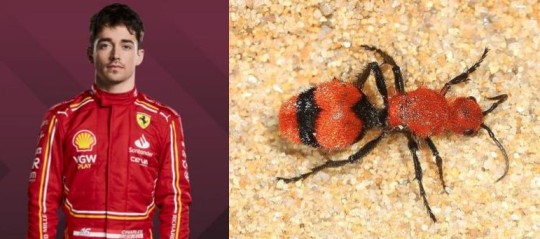
Carlos Sainz - Red Admiral, Vanessa atalanta
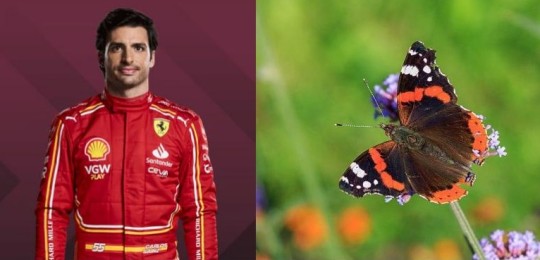
Lando Norris - Walker's Cicada, Megatibicen pronotalis this is NOT meant to be a drag I actually love these freakishly loud animals but he just gives bright green cicada energy.

Oscar Piastri - Green Carpenter Bee, Xylocopa aerata cop out? yeah. good bee and something that feels correct? yes.

Fernando Alonso - Mourning Cloak, Nymphalis antiopa i love these fuckin bugs. absolute freaks of nature. they live for like a full year and they're always wandering around and getting up to something. plus they're very distinguished.
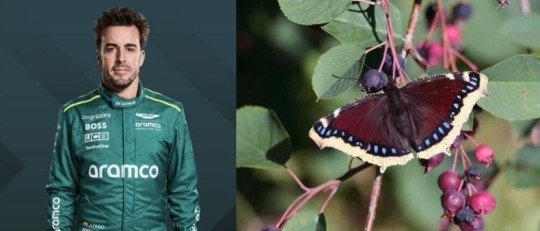
Lance Stroll - Common Buckeye, Junonia coenia I'm not even gonna elaborate on this one.

Valtteri Bottas - Eastern Cicada Hawk, Sphecius speciosus I just think they're neat!
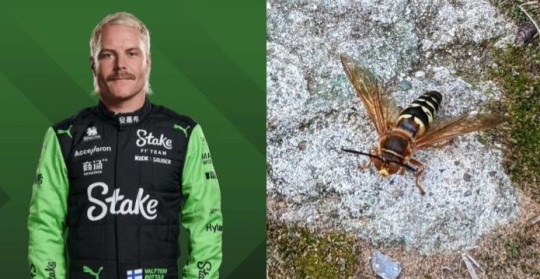
Zhou Guanyu - Ebony Jewelwing, Calopteryx maculata blatant favoritism here. The ebony jewelwing is perhaps my all time favorite bug from home :) (its also v stylish)
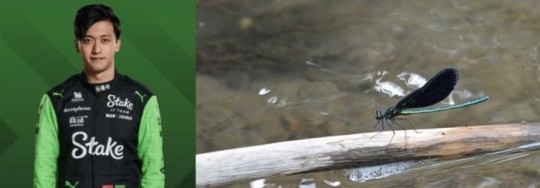
Esteban Ocon - Chinese Mantis, Tenodera sinensis a noble creature that frequently scares the life out of me when i find one outside my window. Why the fuck are you so long. I appreciate u anyway.

Pierre Gasly - European Field Cricket, Gryllus campestris he just *feels* a bit crickety. Idk what to tell u man.

Kevin Magnussen - Halloween Beetle (or in America, the Japanese Lady Bug), Harmonia axyridis the most determined little bastard in the animal kingdom. They WILL get into your apartment through that microscopic sliver in the window.

Nico Hulkenberg - Green June Beetle, Cotinis nitida idk dude he just serves local scarab

Daniel Ricciardo - Black-And-Yellow Mud Dauber, Sceliphron caementarium im sure you are all noticing how much i love wasps by now. i was SO brave not making this a wasp only post. if ur american and a hick (hey girl(gn) hey) you'll know these guys From Constantly Being In Your Car's Inner Workings

Yuki Tsunoda - Bullet Ant, Paraponera clavata tiny but mighty!!!!! (short king solidarity)
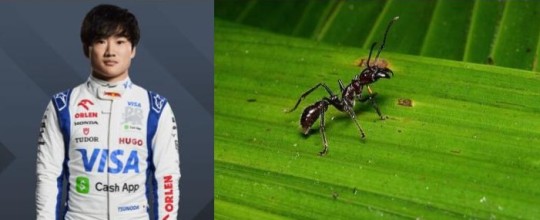
Alex Albon - Great Black Wasp, Sphex pensylvanicus yet more blatant favoritism for my faves. Yes this post is so i can assign the williams boys and zg my fave types of local bugs. Anyway. this is one of the best wasps in the world. if u see her irl please stop for a moment to appreciate her. she's usually a docile species but she is very big and i love her. (good hunter too)
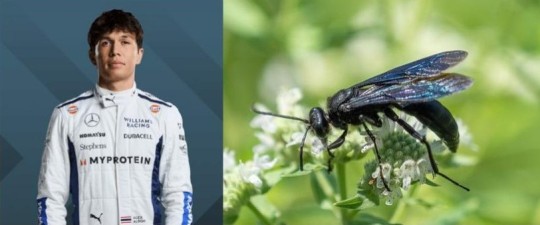
Logan Sargeant - Blue Dasher, Pachydiplax longipennis the ultimate late spring and all of summer insect of america. voted america's sweetheart of every local body of water eight millionth year in a row!!!! one of the best dragonflies in the country and i am serious!!! if u live in north america this summer, find a LAKE, a POND, A RIVER, perhaps even a CREEK!!!!!! A POOL WILL EVEN GET YOU! you'll find these folks. at current you might catch mating flight season!!! anyway. these are crazy good hunters and they're a beautiful little baby blue shade. anyway. logan and the rest of williams should go huntin for these when he gets back to florida. think it would fix em.
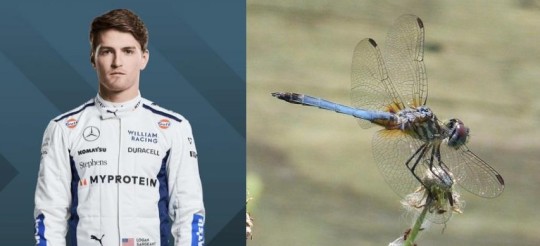
#zoomies posting#kazoo noises#babys first f1 season#sports posting#i said id do it and i was very serious#also sorry for the funky ordering i did this like in order that i thought of them and then had to match the teammates to whoever i did firs#this is why williams are the last ones here. i could NOT decide which wasp alex was gonna be
42 notes
·
View notes
Text
Creating a Backyard Land Spirit Profile
Working with land spirits can help connect you with your local ecosystem, and for some practitioners is a crucial aspect of bioregional magic. Some folks, like myself, consider themselves to be initiated by one or more land spirits.
When I use the term land spirits, I am referring to a few different things. First are the collective spirits of various plants, animals, and insects present in a specific bioregion. An example of collective, in this context, means that if I'm petitioning help from the spirit of violets, I am working with the spirit of all violets present in that area rather than a singe flower that grows in my yard.
The next is the land guardian, which in my practice is a more powerful spirit with claim over a specific territory, like a forest, river, or neighborhood.
Sometimes these two concepts are separate and sometimes they're interchangeable. It all depends on personal practice, culture, local folklore, etc.
One thing that has been extremely beneficial to my practice has been creating a backyard land spirit profile. This method has been useful for spirit work and "green" magic, but more importantly, it's helped me immerse myself in my local ecosystem and I get to meet a lot of cool animals and plants.
Here is an over-simplfied example of my backyard land profile:
Ecosystem: Central Interior and Appalachian: Mixed woodlands, close to possible floodplains
Soil Type: Clay in garden bed, Loamy near/beneath shrubs, Sandy in sunny areas of the lawn
Flora:
Cultivated- Paradise Apple, Highbush Blueberry, Rose of Sharon, Dog Rose, Black-Eyed Susan, Sundial Lupine
Native - Bloodroot, Wild Strawberry, Common Violet, Wrinkle-Leaf Goldenrod, Blue Wood-Aster, Horseweed, Fireweed, Deer-Tongue Witchgrass, Common Milkweed
Invasive - Round-Leaved Bittersweet, Yellow Toadflax, Creeping Bellflower, Common Mugwort
Naturalized - Dandelion, Broad-Leaf Plantain, Deadly Nightshade
Notes - Various mosses, unidentified mushrooms growing on lawn and lichens found on some trees/shrubs.
Fauna:
Mammals - Raccoon, Opossum, Striped Skunk, Grey Squirrel, Chipmunk, Feral Cats, Deer mouse, House Mouse
Birds - Cardinals, Chickadees, Catbirds, American Robin, Downy Woodpecker, Turkey Vulture, Crow
Reptiles and Amphibians - N/A
Fish - N/A
Invertebrates - Dotted Wolf Spider, Leopard Slug, Tiger Bee Fly, Monarch Caterpillars, Peach Root Weevile, Narrow-Winged Mantis, Fireflies
Ecoregion and Soil Type
The first thing I did was determine what type of ecosystem my yard used to be. In an urban/suburban area this was a bit challenging.
I started by identifying a few wild plants and finding out where they usually grow. Most of them seemed to prefer shady woodlands and rich soil. There were also a couple of pioneer species present in the sunnier and more disturbed areas of the yard.
Next, I took a look at surrounding wild areas. We are close to a mountain and a large river. There are woodlands near and within the city made up of mostly hardwood and conifer trees. I knew from memory that certain areas close to my home are likely floodlands.
After that, I found a bioregion map of my country which showed that my state fell under the category of Central Interior and Appalachian. I searched this region on landscope.org and was able to determine my specific ecoregion (not shared here for privacy reasons).
From there I started making educated guesses. I determined that my backyard was likely a mixed hardwood and conifer woodland sitting very close to what might have been a floodplain.
For my soil type, I took samples from different areas of my yard and used an online guide to determine what kind of soil I had. Most of it was sandy or loamy, but my flower beds seemed to have some clay.
Using all this information, I had a general idea of what kind of plants and wildlife would be present without human intervention. It also helped with deciding which native plants to start growing.
Plants
Throughout the year, I went out to the yard with a wildlife field guide and a couple identification apps and identified every plant and insect I found. I grouped the plants into four categories: native, invasive, naturalized, and cultivated. This isn't shown in the example, but I also grouped them by season and the time of year they appear.
Naturalized refers to plants that have integrated themselves into the environment without inflicting damage to the local ecosystem.
You'll notice that under the cultivated section I included a few native plants. This is because those plants were introduced by me and would not be present without my intervention and I wanted to make that distinction.
The importance of native and naturalized plants is obvious, but what about cultivated and invasive? Keeping a profile of invasive plants helped me keep a record of which noxious weeds I need to remove. From an ecological perspective, their removal is crucial to the survival of my native plants and garden crops. From a spiritual perspective, this can be an offering or act of service to the local land spirits. Some of these plants, like Common Mugwort, are both valuable for workings and fine to harvest in large quantities since they are invasive.
Cultivated plants are also important. Many of these plants, like my Blueberries, Apples, and Rose of Sharon, were here before me. The importance of plants introduced by humans is greater than you'd think. First, they are usually crops and flowering plants and provide food for both humans and the local wildlife. Secondly, I live in an urban area, and my land spirits are likely very closely associated with people.
I researched all of my plants and took note of growth patterns, toxicity, medicinal uses, ediblity, native region/habitat, ecological significance/impact, etc. Then I moved onto folklore and symbolism and started working with the spirits of a few plants, performing divination, leaving offerings, harvesting them and including them in rituals and spellwork. I did this in groups to avoid feeling overwhelmed.
Please note that you should always properly identify plants and be aware of potential toxicity before harvesting, especially if you plan on burning or consuming said plant. Also steer clear of protected or threatened plants and keep harvest to a minimum even for abundant native species.
Wildlife
My next project was writing down every species of animal and insect that I had encountered in my yard. I grouped them into several categories: mammals, birds, reptiles, amphibians, fish, and invertebrates. In real life my invertebrates section is separated into several subcategories (orb weavers, beetles, etc.).
Next, I used basically the same system I did for plants, researching their native range, preferred habitat, behavior, diet, ecological importance. Then I started looking into folklore.
Finally, I started integrating them into my practice and working with their collective spirits. This involved using animal symbolism in rituals, leaving offerings, and performing a lot of divination.
Remember to never interact with or directly feed wildlife. If I'm making offerings outdoors it is usually fresh water, scattered birdseed, and acts of service like creating habitats and growing plants that a specific species enjoys. If scattering birdseed, do so in the morning to keep too many animals, like raccoons, from entering your yard at night.
Side note: Keep a record of what appears in your yard each year! For example one year we had several chipmunks and one year I saw none. One year we had no fireflies and the next our backyard was covered in them.
Tying It All Together
Once I had my backyard profile completed, I started working with the collective spirits of select species. I have an offering schedule, perform communication, and petition these spirits regularly in spellwork. I use certain plants that I harvest for offerings and use for tinctures, infusions, cooking, and crafts. I use symbols of local animals in crafts and spellwork.
After working with the "smaller" spirits, you can start seeking out specific land guardians by using a combination of divination and research of local history and folklore.
On a mundane level, I am now able to cultivate an appropriate ecosystem for the local wildlife and start projects to support it. Examples of this are pollinator gardens, stick and brush piles for fireflies and small animals, growing seed-rich and fruiting plants for birds and mammals, winter shelters and TNR plans for feral cats, and more.
I also like to take notes on plants and wildlife that I encounter in my general area that don't usually make it into my backyard. For example there have been coyotes, foxes, bobcats, and black bears spotted in my neighborhood.
I want to stress that I live in a semi-urban and relatively populated neighborhood and I have a small yard. The brief example of of my land profile doesn't cover even a fraction of the wildlife I have encountered in my backyard. There is so much life in urban and suburban areas in need of our support.
#bioregional magic#spirit work#green witchcraft#land spirits#witchcraft#plant magic#local witchcraft
5 notes
·
View notes
Text
Little Book Review: My Sweet Audrina
Author: V.C. Andrews.
Publication Date: 1982.
Genre: Horror but we all know that V.C. Andrews is sui generis.
Premise: Raised in a crumbling estate in the Virginia countryside with her domineering father, wilting violet of a mother, fractious aunt, and cruel cousin, young Audrina Adare struggles to keep track of what time, date, or even year it is. She’s also haunted by the legacy of “the first and best Audrina,” her older sister who died in a mysterious and lurid incident before she was born. Her father claims that their family only has a normal quantity and quality of secrets, but you don’t need a strong grasp of concepts like “Tuesday” in order to smell a rat.
Thoughts: V.C. Andrews’s most famous novel is about four siblings who are trapped in an attic for several years, which should give you an idea of where her strengths lie. She excels when she’s dealing with a small, weird family in a claustrophobic setting, but the moment she has to portray, say, a public high school or (even worse) a small Appalachian town, the spell breaks. My Sweet Audrina is, therefore, the platonic ideal of a V.C. Andrews novel. Audrina’s house, Whitefern (of course it has a name), is miles from anywhere and only accessible by one road. Audrina is locked away from the outside world as a child, and all her attempts to escape or expand her horizons as a teen or young adult are quickly shut down. She loses, gains, and regains various family members, but the end result is that her circle gets even smaller. It’s absolutely horrifying, and also the most satisfying thing Andrews ever wrote. As over-the-top as the events of the novel are, Audrina’s struggles to extricate herself from her family felt all too real. It’s hard to say to what extent she succeeds, but I was totally invested.
Hot Goodreads Take: “Seriously, is there no other way to die than falling down the stairs?” laments one reader. Yes, but for a respectable lady it’s that or childbirth.
19 notes
·
View notes
Text

Early Appalachian families carved out an existence from the wilderness. They cleared and planted small acreages, built solid cabins, and raised their children. Their day-to-day existence was more difficult and isolated than that of people living east of the Appalachians.
Women had many chores to attend to everyday. One of them was spinning cloth on their looms then dyeing color into the cloth. Cloth created on their looms or baskets woven from the white oak they cut and split, they could choose to leave the wool or oak splits in their natural color or dye them with dyes made from sources found in nature. Dye sources were usually collected when they were at their peak in color, but some could be used at any time.
The dye sources would be broken up into small pieces and added to hot water. They would remain in the hot water for at least an hour and then were strained, if necessary, before the actual dye process.
The material being treated would remain in the dye for as long as the woman desired for shade of color. When it was removed from the dye bath, the material was rinsed several times to remove excess dye. To make sure a color would be permanent, mordants were added. The mordants fix the dye to the yarn or split and help them absorb color. The most popular mordants were salt or vinegar. These were available in Appalachian homes. Other mordants could be obtained from a chemical supply house and were used for specific results. Tin gave bright results. Iron gave the darkest results. Alum darkened the color. Chrome gave slightly darker or brassier results than alum. Cream of tartar or tartaric acid brightened color and kept the wool silky
The mordant recipes are detailed:
1. Basic alum recipe: dissolve 3 ounces of alum into ½ cup of warm water and add to
2. Cream of tartar recipe: dissolve one ounce of cream of tartar separately into ½ cup of warm water and add to the dye liquor.
3. Chrome recipe: ¼ oz. of chrome, 4 gallons of water. Dissolve chrome in ½ cup of water.
Stir and heat to simmer before immersing material to be dyed. Cover and simmer for one hour. After the first hour, cut off heat and let cool.
4. Tin recipe: ½ oz. Tin, 2 oz. Cream of tartar, ¾ oz. Oxalic acid, 4 gallons water. Dissolve mordant ingredients separately in ½ cup water. Add to 4 gallons of warm water. Stir after each addition. Bring water to simmer for one hour. Put in material to dye and leave for one hour. Turn off heat and let cool. Rinse out and then rinse and wash again.
5. Iron recipe: ¾ oz. granular ferrous sulfate, ¾ oz. Oxalic acid, 4 gallons neutral waters. Dissolve iron in ½ cup warm water. Add to 4 gallons of water. Dissolve Oxalic acid
separately in ½ cup of warm water. Add to pot. Stir, add wool, and bring bath to simmer for one hour. Turn off. Let wool cool. Rinse. Store until ready to use.
6. Salt or vinegar recipe: ½ pint added to the dye bath before removing material from the dye bath.
Dye sources were readily found in the mountainous regions of the Appalachians. Some of the most common were:
Dye Source Color Mordant
1. Walnut hulls brown not needed
2. Pokeberries red purple vinegar
3. Queen Anne’s Lace light green alum
4. Marigold flower heads gold tin
5. Sweet gum balls gray not needed
6. Willow bark and twigs rose tan to brown not needed
7. Onion yellow salt
8. Coffee or tea tan to brown salt
9. Rhododendron green vinegar
Purple cabbage makes a violet color. Beet juice makes a red-purple, sumac berries make red, and clay dirt makes a sienna color.
The dye material should be heated to a simmer in at least two to three gallons of water. Time will vary for each dye source. If a dye source is powdery or is a small leafy substance, such as tea or coffee, tie it in a cheesecloth .
This sounds like a long process. Can you imagine? AND you still have to cook Supper, but you gotta chop the wood for the fire before you even start cooking, not to mention changing diapers and sweeping the yard.
(Written by Manda Wallace)
19 notes
·
View notes
Text
Vamptember, Day 2
Armand/Daniel | Rating: M | Prompt: Reverse AU | Word Count: 1600
Getting really AU here! Daniel is a vampire created in the 1970s, immediately left by his maker to struggle and figure things out for himself. Fifty years later, he meets a college student in NYC. A story in four months.
This is what he did to pass the nights. Every decade or so, he uprooted to a new city. Got to know the local culture, the fabric of the community. Attended evening classes at the colleges and universities. Collected stories—always itemizing, memorizing, documenting. He’d never stopped chasing the next best thing, the hot lead; it changed every night.
His creator hadn’t had much use for him before or after the fact—a blond-haired demon in the night that vanished almost as soon the deed was done. No matter, Daniel had made his own way over the past fifty years, since that damp evening in New Orleans in 1973.
What choice did he have?
He’d never made another, didn’t know how to. Never met another of his kind either, not including the one who’d abandoned him in the dark. His companions were the people he met along his trips, those that hankered to spill their guts to a handsome, violet-eyed stranger with a young man’s earnest, trustworthy grin.
—
September
It’s an art class at NYU. First class of the semester. The air warm and compressed with the scents of perfume, product, caffeine, nicotine, all the scents dragged off the streets of Manhattan—and of course, blood. Young and innocent and excitable.
But Daniel won’t feed from these youth, not in this decade anyway. He has never been able to stop before the point of no return. With no mentor, it was trial and error—much, much error—to realize that the ones he identified the most with, the ones he wanted to take into his arms to cherish and embrace, weren’t the ones he could connect with in the most intimate expression he had left.
He was never able to bring them back.
—
Daniel hears him before he ever sees him.
A loud laugh, almost childish in its uninhibition and audio frequency, the sound echoing throughout the classroom as he walks in, looking over his shoulder at a classmate.
Just a kid, Daniel thinks, because he himself is easily five decades older and at least two generations removed.
“Armand, come!" the kid's companion urges.
Armand.
It’s a pretty name. French in origin. Daniel tries it out without opening his mouth, feeling his tongue try to curl around the R.
Uncommon, but this was New York.
Daniel takes in everything, from the cascading dark auburn curls to the black combat boots. Seeing each feature separately and then combining them into the whole again.
There's a delicate androgyny to the face that would have had Daniel puzzling over the kid's gender—if the bossy friend hadn’t elected to use the masculine pronouns when referencing him to someone else in their little group. It corresponded with what Daniel can see outlined in Armand’s skin-tight leather pants, like he’s been sewn into them—trends from Daniel’s era had become new again. Shorter than average for a man his age then, the top of Armand's head would barely clear Daniel’s shoulder.
Almost as if he's hearing this descriptive analysis of his person, Armand whips his head around and catches Daniel's stare head-on. Smiles and makes his way over, chin tilted upwards.
His eyes large—too large—brown, and playful. And yet, there's an overwhelmingly melancholic quality to them that makes Daniel’s chest clench, in the same inexplicable way the sound of a train whistling in the distance once broke the heart of a lonely country boy in the Appalachians each night the Norfolk Southern freights passed through.
He wants this kid’s story.
“Hey, I'm Armand," the voice is low, breathy, “Is this seat taken?”
—
The kid, Armand, becomes Daniel's new friend for the season.
He’s talkative, and Daniel’s enquiring. He enjoys being the center of attention, and Daniel enjoys watching him in his element. He's sweet and sensual, liberated, and expressive in a way the homosexual men of Daniel’s era could never have been in the mainstream culture of the time period.
Daniel finds himself in Armand's apartment in Greenwich Village after class; first two, then three times a week. It's right there—a ten minutes walk away from campus.
Dangerous, frightening, how quickly Daniel fell into a routine with this one.
It’s easy.
It’s too easy.
Just get the stories and go, Daniel told himself.
But when Armand poured him the booze Daniel was never going to drink, opened the window to climb out onto the fire escape three floors up, laughing at the hesitance he saw written on Daniel’s face—misreading it entirely—coming to nuzzle comfortably against his collarbone, “What, are you scared of heights all of a sudden, Danny?” Daniel knew.
He wants to tell the kid to stop, knock it off, toughen up, man up—that he’s too sympathetic and enthusiastic to go out into the world behaving this recklessly, this trusting.
There’s dangerous people out there.
You’re gonna get hurt.
—
October
Armand leans against the railing, exhales a vape cloud into the sky, the strawberry scent cloyingly artificial.
"Kiss me," he says, his mouth smiling while his dark eyes issue the challenge, masking the plea Daniel can hear as loud and clear as the siren wailing in the distance.
He’d dropped two before going to class. He should be able to manage this, an innocent kiss. Tells himself this is the limit; he’ll enjoy Armand’s company until the kid eventually gets fed up when Daniel can’t offer him anything more and moves on. Sure, he might sulk for a week or two, but he'll soon land on his feet.
He's twenty-one; what does a twenty-one-year-old know about life?
Daniel won't ruin this one. He'll eat before, as many as it takes. Swears he'll never let things escalate to any form of physical intimacy anyway, beyond this.
Meeker, more submissive than expected, and Daniel's grateful for it. His mouth is warm, pliant, and giving, just like the rest of him. It allows Daniel to take control and prevent him from nicking himself on a fang. He’s placing a tremendous amount of trust in the belief that his instincts won’t win out this time, but he’d rather not test it after…
If Armand thinks Daniel feels wrong, he doesn't react, and his thoughts are calm and subdued enough that Daniel can't pick them up.
He pulls back, sees the kid's black lashes fluttering in the muted glow of Manhattan at night, dusting his cheekbones as he struggles to catch his breath, looking up at Daniel like he'd just hung the goddamn moon.
Fuck.
The sky has begun transitioning from black to violet when he lies about being late for work.
Armand’s exhausted, delirious. Jittery from the stimulant comedown, the night chill, the incessant surge of endorphins and hormones.
He trembles in Daniel’s arms, a whisp of a thing. Lips swollen from hours of making out, cheeks pink from cold, his heartbeat so loud and erratic—Daniel imagines it bursting out of Armand’s chest cavity, bathing them both in the delectable red warmth he can feel pulsating right beneath his fingertips. His throat aches and his mouth opens involuntarily, as if anticipating the arterial spray.
Armand stands on tiptoe, pressing one last kiss to his hard jawline.
“Text me later?”
“Later,” Daniel promises.
—
November
Armand calls Daniel his boyfriend now.
Dating has become much more complex and somehow more informal since the last time Daniel did it.
There's an expiration date on this "relationship." Seeing it looming in the distance, a flashing neon sign to an exit ramp in pitch darkness, makes him restless and agitated—which in turn, produces the inevitable natural consequences.
Armand screaming in Daniel’s face, no longer sweet-tempered and soft-hearted. Hurt and rage bringing about the most exquisite flush to his face and neck, the valves of his heart slamming open and shut, his jugular emphasized from the pressure building in his young chest. Completely unaware he may as well be laying himself down on a sacrificial altar.
More tempting was this display to Daniel’s basest desires than any of the nights he’d spent working the kid open, whispering sweet nothings in his ear as Armand buckled and shuddered against him, wailing Daniel’s name in the dark bedroom.
His insides searingly hot as he locked around Daniel’s three fingers, the sweat on his thighs tangy and salty—all of it a tease, a mockery of the red elixir coursing just below the paper-like skin.
And still, it paled in comparison to the passion and intensity of his fits.
—
December
Three unwelcome truths started to arise unbidden after each explosive quarrel, after each of Armand’s tearful outbursts—why can't we go out during the day? are you ashamed of being seen with me? what are you hiding? why can’t I touch you? why don’t you want to fuck me? what’s so wrong with me, Daniel? say it, I dare you, just fucking say it!—after each argument that Daniel stormed out, convinced if he stayed a second longer, he'd slaughter him right where he stood. Armand cursing his name loud enough for all of New York City to hear.
First, he was never supposed to get this far.
Second, he’d gotten the story he’d come for, and it was as tragic as he could have predicted. A tale to be shelved and revisited at a later date once the attachment had passed.
But last, and most importantly, Daniel had been this for so long, fixated on avoiding the literal and tangible collateral damage, he’d forgotten… until the damning pile of evidence couldn’t possibly be ignored any longer…
There was more than one way to ruin a person.
#y’all didn’t check on me all day & this is what I did#I actually had to cut it down RIP#if brevity is the soul of wit… well ;-;#vamptember#prompts#vc
39 notes
·
View notes
Text
Safely back from this weekend's LARP event in Pennsylvania! I got to have my combat therapy and time with good friends and the eternal joy of having the Appalachians under my feet once again. My dear old mountains, how I've missed you. 💜
Apart from the usual fun of making potions, fighting monsters, and being exceptionally clever (my character made some Very Good Decisions this game), I got to do some foraging on the hillside before the event started, with my good buddy and witch-sis @wind-voice. We found and identified several species of local flora and gathered small bundles of speedwell, ground ivy, violets, juniper, and periwinkle for our witchery.
I'm really enjoying this new stage in my journey, connecting to the land that I now live on and to the land in other places I've called home. Identifying the trees and flowers and incidental weeds around me is a fun exercise that lets me feel a little bit witchy even when I'm just taking a stroll around the neighborhood. It's also allowing me to add new accoutrements to my components stores and rebuild my herb cabinet, much of which had to be discarded during our recent move.
Also, we all know that if you give a witch a bundle of herbs, they're going to need a jar to put it in, so I'm looking forward to making a little trip to the craft store! 😁
19 notes
·
View notes
Text
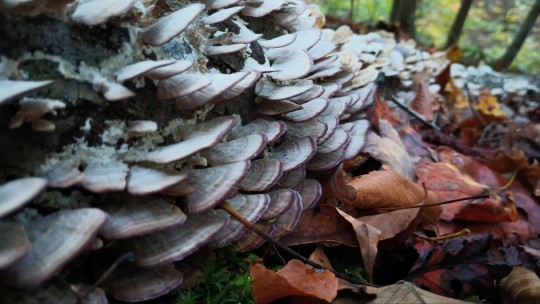
ID by: me, as Violet Toothed Polypore
Found and photographed: on an appalachian mountain biking trail in West Virginia
These mushrooms are practically everywhere, if you've ever been in a forest you've surely seen them. But you probably didn't know there's one place they avoid.
See more photos, and learn about Violet Toothed Polypores below the cut!


These mushrooms are one of our most prolific mushrooms around, but they can't grow everywhere. Specifically avoiding coniferous woods such as pines, spruce, and most evergreens.
The high acidity of evergreens keeps this specific species at bay, but a look alike "Trichaptum abietinum" thrives on conifers.
Edibility: Inedible
Rarity: Extremely Common
Genus: Trichaptum
Regions: Europe, Western Asia, Australia, North America, South America
Please do your own research, I am an enthusiast not a scientist. I'm here to share and have fun.
All photos taken by me: Toast Loafley/Juno S.
2 notes
·
View notes
Text
Today's Horoscopes
If you are a Sagittarius... ✧ Keep an eye out for coins on the ground today. There may be free chewing gum underneath.
If you were born on a Tuesday... ✧ If you see a flock of robins circling your house, don't go outside! They are trying to steal your credit card number.
If your birth date has a 6 in it... ✧ Try a new food today. If you hate it, this is probably because of a wizard's curse. If you like it, this is also probably because of a wizard's curse. You have a wizard's curse. You should probably see a doctor or something.
If your birth month ends in a "y"... ✧ This week is going to be good for your love life, but only if you are interested in guys who are 5'6" and named Joe. I've seen four of them on Tinder in the past week, and suspect they are being created in a lab somewhere in the greater Detroit area.
If your favorite color is teal... ✧ Check your tire pressure. The changing seasons can make your tires seem over-inflated or under-inflated as the temperatures fluctuate.
If you are near-sighted... ✧ You will receive a spam phone call today and the robotic voice on the other end of the call will sound shockingly like your eighth grade math teacher.
If your fursona is a tiger... ✧ Hell yeah, tigers are cool. You're cool.
If you are a Pisces... ✧ Did you know that the Appalachian Mountains are 480 million years old?
If your favorite food is spaghetti... ✧ Take an umbrella with you if you go out tomorrow.
If you're left-handed... ✧ There's a song you keep hearing on the radio at work that's driving you crazy, isn't there? Bad news: it's because that song is what will play when you die.
If you drive a 1999 Toyota Corolla... ✧ Violets are an indicator of good luck in your future. Tulips are an indicator of bad luck. Dandelions are an indicator that your lawn is too monocultural and would benefit from the introduction of some different species of grasses, clovers, or wildflowers.
If your name ends with a "p"... ✧ Haha. Pee. Anyway, stay hydrated!
0 notes
Text

NEW FROM FINISHING LINE PRESS: The Lady of the Lake Had Bouffant Hair by Angela Vaughan Clevinger
ADVANCE ORDER: https://www.finishinglinepress.com/product/the-lady-of-the-lake-had-bouffant-hair-by-angela-vaughan-clevinger/
Angela Clevinger is a Reading Specialist in Pulaski County, Virginia with an educational career spanning over two decades. She has been published in many educational publications, giving a voice to students and teachers, presenting their needs in a public and sometimes political arena. She uses her poetry to help her heal from a trauma filled childhood and to help others find their voice and power as well. She uses humor, strength, and truth to tell her stories which journey through surviving to thriving. Angela embraces her Appalachian Culture and brings magic to the page. She lives with her husband Larry, two daughters Emma and Violet, and three cats Dobby, Frodo, and Thomas J. O’Malley.
PRAISE FOR The Lady of the Lake Had Bouffant Hair by Angela Vaughan Clevinger
From a background of childhood trauma come these poems of resilience, humor, and honesty. Angela V. Clevinger captures the harsh realities of childhood while celebrating the imagination and compassion that make survival possible. The Lady in the Lake Had Bouffant Hair is by turns rollicking and heartbreaking, with deep connections to the mythic and spiritual.
–April J. Asbury, author of Woman with Crows
Powerful words paint a vivid portrait of Angie Clevinger’s lipstick-red and cigarette-blackened childhood. She remembers the complexity of gossip, sad and bitter conversations heard from her hiding place underneath the table. She writes these poems from her view of painted toenails, platform heels, and drifting smoke. Maturity brings clarity and loving emotion to the writer, and the lyrics sung by Dolly, Reba, and others are Angie’s lyrics.
–Donia Eley, author of Writers By the River
Prepare yourself for big hair, lipstick-stained cigarettes, and a whole lot of love. These ladies of the lake tell the truth and like to laugh, even at the smoky truth of death, so hold on and enjoy.
–Jim Minick, author of Fire Is Your Water
Please share/repost #flpauthor #preorder #AwesomeCoverArt #read #poems #literature #poetry #childhood #trauma #healing
#poetry#preorder#flp authors#flp#poets on tumblr#american poets#chapbook#leah maines#women poets#chapbooks#finishing line press#small press#book cover#books#publishers#poets#poem#smallpress#poems#binderfullofpoets
0 notes
Photo

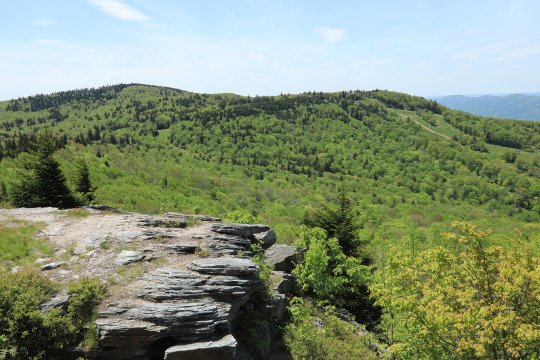

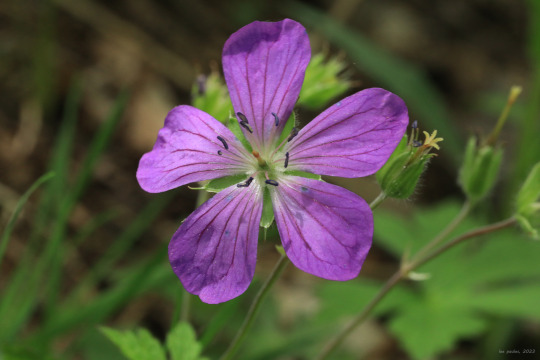


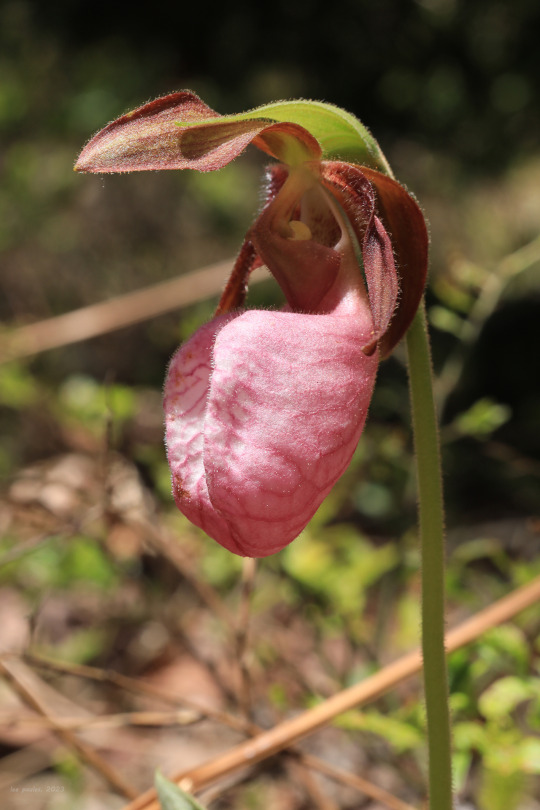



The photos above are from a trek to the summit of Bald Knob in Tucker County, West Virginia earlier today. Bald Knob Trail starts in Canaan Valley State Park and crosses into the Monongahela National Forest before returning to the state park. Many people avoid the steep ascent on foot and take a chair lift from the adjacent ski area instead. I manned up today and made the ascent by foot so I could beat the lazy tourists to the overlook.
From top: the view from Bald Knob toward Weiss Knob and the Canaan Valley State Park ski area; wild geranium (Geranium maculatum), a clumping woodland perennial with gorgeous violet-purple foliage and elegant, sharply-lobed foliage; minniebush (Menziesia pilosa), an Appalachian endemic with distinctive, white-tipped leaves; painted trillium (Trillium undulatum), which has a fondness for shady spots in the strongly-acidic soils of old forests; pink lady’s slipper (Cypripedium acaule), another lover of shady nooks and strongly-acidic soils; and the mysterious depths of the boreal forest at the summit, where Canada mayflower (Maianthemum canadense) and yellow Clintonia (Clintonia borealis), also known as bluebead lily, form dense colonies in the rich humus.
#appalachia#vandalia#west virginia#allegheny mountains#canaan valley#canaan valley state park#monongahela national forest#bald knob#wild geranium#minniebush#painted trillium#pink lady's slipper#canada mayflower#yellow clintonia#bluebead lily#flora#wildflowers#orchid#may#spring
156 notes
·
View notes
Video
Jack in the Pulpit by Violet Bliss Dietz
Via Flickr:
Found alongside the path on a section of the Appalachian Trail called the River Walk near Kent, Connecticut. It was hiding out under that leaf. First time I've seen one in the wild though who knows how many I've walked past and never noticed because they blend in remarkably well. more Flowers Pentax K-3 - SMC Pentax DA 55-300mm F4-5.8ED (IMG35376ec2a3)
#Pentax#K-3#vbd#SMC Pentax DA 55-300mm F4-5.8ED#CT#Connecticut#flower#New England#green#Jack in the Pulpit#Appalachian Trail#2016#spring 2016#wildflower#manual focus#handheld#leaf#leaves#flickr
1 note
·
View note
Text
Zesht Lijep - Career Infodump

Zesht Lijep (ugly in Farsi, pretty in Bosnian) is a trio project which is comprised of Khmer-American musician Franny Sor Robinson and an Iranian-German musician and a Bosnian-Swedish musician. The three of them released dual debut albums: one has indie pop vibes, which surprises casual Franny Sor Robinson listeners, but if you’re a die hard stan you know that Franny has written numerous pop songs before and in fact the money from co-writing pop music helps to allow her to make the music she’s passionate about. The songs on this album are primarily in English, with one song sung in English, Khmer, Bosnian, and Farsi.
The other, is their passion project album, where the three of them combine folk songs and instruments from their cultures (Bosnian, Swiss, German, American, Swedish, Iranian, and Cambodian) with folk instruments from each others’ cultures and modern instruments - think what Altın Gün does for traditional Turkish songs, what The Hu does with metal and Mongolian throat singing, Rhiannon Giddens pairing a traditional Iranian drum with an Appalachian folk song, and Trio Mandili’s whole vibe. The finished songs generally have a groovable rhythm like Altın Gün’s funky, psychedelic offerings, and drum kits and bass guitars are seamlessly paired with traditional stringed, percussion, and flute-like instruments.
Members:
Franny Sor Robinson
Dada Prazina, fronts a band in Sweden with the name Prazina because everyone thought her surname was cool (fc: Ilma Karahmet), ethnic Bosnian, Swedish-Bosnian dual citizen
Mahvash Shirazi, stage name “MAVA” stylized in all caps (fc: Hasti Mahdavifar), ethnic Iranian, Iranian-German dual citizen
Mahvash was a biiiig Franny Sor Robinson stan for years and they became friends while she toured with Seoul Hanoi’d as the opening act under the stage name MAVA on the European leg of one of their tours. MAVA’s solo music is like, Conan Grey and Phum Viphurit vibes. Dada is the frontwoman of a band in Sweden with Hey Violet and Kississippi vibes. Dada’s band is called Prazina because her Swedish bandmates thought her last name was cool as hell.
Franny has appeared as a featured singer on two of MAVA’s songs and one song with Prazina, and she’s written songs for both in the last couple years, so Zesht Lijep isn’t Dada and Mahvash’s first time working with Franny, this is just the three of them working on a passion side project together.
Pretend the instrumentation is super cool and groundbreaking stuff, I just have no musical talent so I tried to describe the songs but *upside down smiley here*
The tracklist for their album, Everything Blossoms and Everything Blooms (named for a Bosnian Sevdalinka song of the same name called Sve behara i sve cvjeta) is as follows:
1. Hele Mali; Farsi
Mahvash sings lead
There’s a groovy bass line
Along with a drum kit there’s some traditional Iranian drums used, peep this version of it for a large selection of diff Iranian drums
Franny also plays tro, a traditional Cambodian fiddle, on parts of the track. Listen to this 80s version of Hele Mali and you’ll see where the tro parts might fit
2. Sve behara i sve cvjeta (Everything Blossoms and Everything Blooms); Bosnian
This song is sung with Dada leading and Franny and Mahvash providing harmonies
The beat is established using a drum kit
There’s an accordion ofc and a melodica is used similar to the accordion in the song if that makes sense lmao
I wish I was musically gifted but alas
3. Sat Tee Touy (Look at the owl); Khmer
Franny sings lead and Dada provides harmony; Franny describes this song as five rabbits are selling drugs
This song is percussion driven, BUT a drum kit is barely used. Rather, traditional Iranian and Cambodian drums combined provide the bouncy, danceable beat
A tro is used as well as a kamencheh
A guitar and bass guitar and double bass are also used
4. Avaz on Rumi Sonnet (Isfahan); Farsi, look at this GORGEOUS translation
Franny actually sings lead on this one
Franny took lead on this song as a challenge to really improve her Farsi
It starts out with just their voices until a tanboor (like on the sample version) begins to play, followed by a mandolin and Franny then begins picking her banjo
The tanboor and their voices are front and center, only backed up by the mandolin and banjo
5. Herr Mannelig (The Courting of the Mountain Troll); Swedish
Dada sings lead on this song
Acoustic guitar is played by Mahvash and mandolin by Franny
Traditional Iranian percussion instruments are used
A swedish instrument resembling bagpipes is used as is a melodica
6. U Stambolu Na Bosforu (In Istanbul on the Bosphorous); Bosnian
Franny sings lead on this one with Dada coming in with devastatingly gorgeous harmonies
Franny plays acoustic guitar, Mahvash plays the tar, and keeping time is Dada playing a simple rhythm on a little drum that sits in her lap
7. Es führt über den Main, German, German folk song
Franny and Mahvash sing this as a duet, Franny providing the higher harmonies
This song is mainly supported by Iranian instruments – okay tell me the medieval instrumentation of the example doesn’t make you go “ohhh traditional Middle Eastern instruments thooooo”
8. Arkansas Traveler; English, American folk song using these lyrics
Dada sings lead on this one
This song features double bass, some percussion from Iran throughout, some and a guitar
9. Zapjevala sojka ptica (The Blue Jay Bird Sang); Bosnian
Mahvash sings lead on this one
Drums from Iranian music are prevalent, along with melodica, some synth use, guitar, and bass guitar
10. Shenandoah; English, American folk song
Franny, Mahvash, and Dada sing in harmony throughout
Dada plays guitar, Mahvash plays tanboor, (listen how well they go togetherrrr) and filling out the song are some percussion instruments from Cambodia and Iran gently chiming in
11. Wildwood Flower, English, American folk song
Franny has recorded a version of this song on a Dara & Danny album before, so Dada takes lead and Franny sings harmony
The instrumentation is stringed instruments from Cambodia, Iran, and of course a mandolin
12. O Death, English, American folk ballad
Mahvash starts this song out a capella, her voice lilting as if singing in Farsi on the extended phrases
Slowly, instruments are added including Franny on banjo, and some stringed instruments from Iran, a kick drum, and a daf (a drum from Iran)
Dada and Franny eventually provide harmonies
This one hit you in the feels
13. Arapiya; Khmer
Franny challenged Mahvash to sing lead here, and it's a simple Khmer song so it just took practice
Much of the instrumentation is traditional Khmer instruments but Franny adds a Western fiddle in addition to the tro, and Dada plays accordion
There’s also acoustic guitar, bringing a modern feel to the song, and European style and Khmer style flutes like in this version
14. Keep On The Sunny Side, English, American folk song
Franny sings lead and plays autoharp
Mahvash plays a tanboor, there’s guitar, good shit
0 notes
Note
So how would Trin, her best friend and the rest of your ocs
react to each of the factions in fallout 76?
Prepare for a long list of which factions I think a ton of my OCs would be most inclined to cooperate with:
Raiders (both old and new): Lara, Sid
Settlers: Dana
Appalachian BoS (both old and new): Trin (reluctantly, but it is what she's familiar with), Kayli, Summer
Responders: JJ, Tibbs
Free States: Ness
Cult of the Mothman: Grace
Order of Mysteries: Violet, Natalia, Sigrid
Wouldn't associate with any: Charlie, Brutus
1 note
·
View note